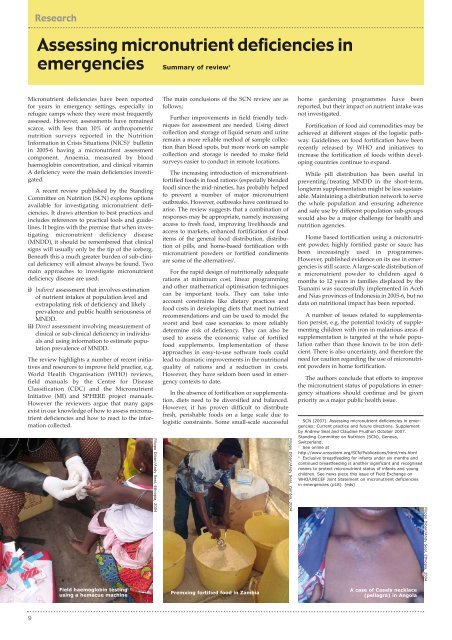Scoop situation - Field Exchange - Emergency Nutrition Network
Scoop situation - Field Exchange - Emergency Nutrition Network
Scoop situation - Field Exchange - Emergency Nutrition Network
- No tags were found...
You also want an ePaper? Increase the reach of your titles
YUMPU automatically turns print PDFs into web optimized ePapers that Google loves.
ResearchAssessing micronutrient deficiencies inemergencies Summary of review 1Micronutrient deficiencies have been reportedfor years in emergency settings, especially inrefugee camps where they were most frequentlyassessed. However, assessments have remainedscarce, with less than 10% of anthropometricnutrition surveys reported in the <strong>Nutrition</strong>Information in Crisis Situations (NICS) 2 bulletinin 2005-6 having a micronutrient assessmentcomponent. Anaemia, measured by bloodhaemoglobin concentration, and clinical vitaminA deficiency were the main deficiencies investigated.A recent review published by the StandingCommittee on <strong>Nutrition</strong> (SCN) explores optionsavailable for investigating micronutrient deficiencies.It draws attention to best practices andincludes references to practical tools and guidelines.It begins with the premise that when investigatingmicronutrient deficiency disease(MNDD), it should be remembered that clinicalsigns will usually only be the tip of the iceberg.Beneath this a much greater burden of sub-clinicaldeficiency will almost always be found. Twomain approaches to investigate micronutrientdeficiency disease are used:i) Indirect assessment that involves estimationof nutrient intakes at population level andextrapolating risk of deficiency and likelyprevalence and public health seriousness ofMNDD.ii) Direct assessment involving measurement ofclinical or sub-clinical deficiency in individualsand using information to estimate populationprevalence of MNDD.The review highlights a number of recent initiativesand resources to improve field practice, e.g.World Health Organisation (WHO) reviews,field manuals by the Centre for DiseaseClassification (CDC) and the MicronutrientInitiative (MI) and SPHERE project manuals.However the reviewers argue that many gapsexist in our knowledge of how to assess micronutrientdeficiencies and how to react to the informationcollected.<strong>Field</strong> haemoglobin testingusing a hemacue machineFilippo Dibari/Andy Seal, Ethiopia, 2004The main conclusions of the SCN review are asfollows;Further improvements in field friendly techniquesfor assessment are needed. Using directcollection and storage of liquid serum and urineremain a more reliable method of sample collectionthan blood spots, but more work on samplecollection and storage is needed to make fieldsurveys easier to conduct in remote locations.The increasing introduction of micronutrientfortifiedfoods in food rations (especially blendedfood) since the mid-nineties, has probably helpedto prevent a number of major micronutrientoutbreaks. However, outbreaks have continued toarise. The review suggests that a combination ofresponses may be appropriate, namely increasingaccess to fresh food, improving livelihoods andaccess to markets, enhanced fortification of fooditems of the general food distribution, distributionof pills, and home-based fortification withmicronutrient powders or fortified condimentsare some of the alternatives 3 .For the rapid design of nutritionally adequaterations at minimum cost, linear programmingand other mathematical optimisation techniquescan be important tools. They can take intoaccount constraints like dietary practices andfood costs in developing diets that meet nutrientrecommendations and can be used to model theworst and best case scenarios to more reliablydetermine risk of deficiency. They can also beused to assess the economic value of fortifiedfood supplements. Implementation of theseapproaches in easy-to-use software tools couldlead to dramatic improvements in the nutritionalquality of rations and a reduction in costs.However, they have seldom been used in emergencycontexts to date.In the absence of fortification or supplementation,diets need to be diversified and balanced.However, it has proven difficult to distributefresh, perishable foods on a large scale due tologistic constraints. Some small-scale successfulPremxing fortified food in ZambiaFilippo Dibari/Andy Seal, Zambia, 2004home gardening programmes have beenreported, but their impact on nutrient intake wasnot investigated.Fortification of food aid commodities may beachieved at different stages of the logistic pathway.Guidelines on food fortification have beenrecently released by WHO and initiatives toincrease the fortification of foods within developingcountries continue to expand.While pill distribution has been useful inpreventing/treating MNDD in the short-term,longterm supplementation might be less sustainable.Maintaining a distribution network to servethe whole population and ensuring adherenceand safe use by different population sub-groupswould also be a major challenge for health andnutrition agencies.Home based fortification using a micronutrientpowder, highly fortified paste or sauce hasbeen increasingly used in programmes.However, published evidence on its use in emergenciesis still scarce. A large-scale distribution ofa micronutrient powder to children aged 6months to 12 years in families displaced by theTsunami was successfully implemented in Acehand Nias provinces of Indonesia in 2005-6, but nodata on nutritional impact has been reported.A number of issues related to supplementationpersist, e.g. the potential toxicity of supplementingchildren with iron in malarious areas ifsupplementation is targeted at the whole populationrather than those known to be iron deficient.There is also uncertainty, and therefore theneed for caution regarding the use of micronutrientpowders in home fortification.The authors conclude that efforts to improvethe micronutrient status of populations in emergency<strong>situation</strong>s should continue and be givenpriority as a major public health issue.1SCN (2007). Assessing micronutrient deficiencies in emergencies:Current practice and future directions. Supplementby Andrew Seal and Claudine Prudhon October 2007.Standing Committee on <strong>Nutrition</strong> (SCN), Geneva,Switzerland.2See online athttp://www.unsystem.org/SCN/Publications/html/rnis.html3Exclusive breastfeeding for infants under six months andcontinued breastfeeding is another significant and recognisedmeans to protect micronutrient status of infants and youngchildren. See news piece this issue of <strong>Field</strong> <strong>Exchange</strong> onWHO/UNICEF Joint Statement on micronutrient deficienciesin emergencies (p18). (eds)A case of Casals necklace(pellagra) in AngolaFilippo Dibari/Andy Seal, Ethiopia, 20049
















